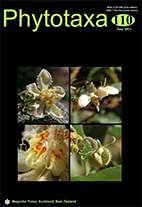Abstract
Morphological and molecular phylogenetic evidence strongly demonstrated the paraphyly of the Genistoid legume genus Diplotropis with respect to the recently described monospecific Guianodendron (a segregate of Acosmium sensu lato). In order to achieve a phylogenetically based classification of the group, the new Amazonian genus Staminodianthus D.B.O.S. Cardoso, H.C. Lima & L.P. Queiroz is described and illustrated to accommodate three species previously placed in Diplotropis sect. Racemosae. We present a synopsis for Staminodianthus, including geographical distribution, lectotypification, and new species circumscriptions of the following three new combinations: Staminodianthus duckei (Yakovlev) D.B.O.S. Cardoso & H.C. Lima, Staminodianthus racemosus (Hoehne) D.B.O.S. Cardoso & H.C. Lima, and Staminodianthus rosae (H.C. Lima) D.B.O.S. Cardoso & H.C. Lima. Staminodianthus differs most notably from its sister genus Guianodendron by having bilaterally symmetrical flowers, calyces with a curved hypanthium, a well-differentiated standard petal, lateral and lower petals without auricles, and the androecium with a combination of five fertile stamens and five short staminodes, a unique feature within the Genistoid legumes.

